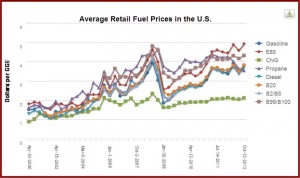Two special interest groups are sparing in public over the cost implications of a long-standing federal energy policy that mandates the use of ethanol and ever increasing amounts of bio-fuels in an attempt to free the United States from importing oil sold by terrorist supporting nations. In 2012 about 9% of all transportation fuel used will be from so-called renewable sources.
When President Bush and the Congress passed the controversial Energy Independence and Security Act of 2007 with Democratic support, the stated purpose was to have 20% of all fuel used by 2022 to come from U.S.-made renewable fuels to free the country from the ongoing national security and economic issues caused by importing foreign oil from totalitarian and terrorist supporting nations. This Act built on the renewable fuel program that was adopted in the Energy Policy Act of 2005, and it had bi-partisan support. EPA oversees the so-called Renewable Fuel Standard.
This worthy goal was going to be helped in the EISA bill by the elimination of billions of dollars in taxpayer subsidies going to big oil, but not surprisingly in pay-to-play Washington, the subsidies remained when the final bill emerged from a closed conference committee meeting reconciling House and Senate versions of the bill. It was also not a surprise that subsidies were given to farm states to produce the ethanol that was required in the bill.
Virtually every gallon of gasoline sold in the U.S. right now contains ethanol: 98% as E10 – up to 10% ethanol for conventional autos, and 2% as E85 – 85% ethanol/15% gasoline for use in flex fuel vehicles only. The problem remains we are not even currently close to achieving the mandated usage goals even though current projections have ethanol fuel use at more than 14 billion gallons in 2012.
The Environmental Protection Agency oversees the so-called Renewable Fuel Standard created by the legislation, and EPA can under certain circumstances to waive the volume requirements. This summer food interests asked EPA to waive the ethanol requirements because the drought in the U.S. was raising corn prices. EPA refused saying that its analysis shows that it is “highly unlikely” that waiving the RFS volume requirements would have a significant affect on ethanol production or use in the during the 2012-2013 corn marketing season. EPA concluded that there would be little or no impact on corn, food, or fuel prices.
“We are very disappointed in the Environmental Protection Agency’s decision not to grant a waiver from the Renewable Fuel Standard ethanol mandate,” according to Rob Green from the National Council of Chain Restaurants, whose members claim that using ethanol for fuel is increasing the price of fast food.
Brent Erickson of the Biotechnology Industry Organization, countered, “The latest attack on America’s renewable energy policy blames biofuel for food cost increases while ignoring the 300-pound barrel of imported oil in the room.” Biotech’s members profited handsomely from taxpayer subsidies and protectionist tariffs for converting corn formerly used as feed to feedstocks for ethanol fuel, which arguably raised the price of food somewhat. (As to chain restaurants complaining, well first that requires you to consider factory made fast food, well, food, instead of the enabler of public health obesity problems it is causing with America’s obsession with fast food.)
Starting in January of this year some of the more egregious subsidies for fuel production by agribusiness were eliminated, not that lobbyists wouldn’t like to see them restored.
U.S. taxpayers were handing agribusiness a subsidy of almost $7 billion annually to use corn to make ethanol, that totaled to more than $40 billion in pork – err corn – since the act’s passage. These subsidies are now gone, (a 45-cent a gallon subsidy for ethanol blenders) and a protectionist tariff of 54 cents per gallon was dropped that blocked much more efficient Brazilian sugar-cane derived ethanol, even though using Brazilian ethanol does nothing to help U.S. energy independence.
It remains to be seen how ethanol – specifically E85 – now does at the pump. Currently it is not competitive with the slumping price of oil. In gasoline-gallon equivalents (GGE or adjusted for the amount of energy in a gallon of gasoline) E85 is currently selling for $4.91 a gallon on average.
As for E10 – and the newly proposed E15 blends but not really on sale yet – drivers will have no choice, it will continue to be forced on them by the law, even though there are genuine concerns about the negative effects of E15 on many engines. Only about 12 million out of the more than 240 million light-duty vehicles on the roads today are approved by manufacturers to use E15 gasoline, based on a survey conducted by AAA of auto manufacturers. (Read AutoInformed on: D.C. Court Throws Out E15 Lawsuit on a Technicality, and Study Claims E15 Ethanol Gas Will Damage New Car Engines, EPA Finally Decides 2012 Renewable Fuel Standards, and EPA Finalizes E15 Gasohol Pump Labels as Automakers Again Protest Adding More Ethanol to Gasoline. Lawsuits Pending)
The real long-term solution envisioned in the law is the production of ethanol from agricultural waste, so called cellulosic fuel, but so far in spite of some promising demonstrations it is not competitive. It’s in the national interest to keep pressing forward here.
Aside from being an amusing spat from profit making groups who want to keep feeding at the public troughs, the charges and counter-charges once again point out how complicated serious national policy and security issues become in a U.S. political system that is blatantly for sale to moneyed interests. Even with the progress on alternative fuels, The U.S. sends over $1,000,000 a minute to oil exporting nations, many of whom are hostile to us. For the moment, it appears that the national interest of independence is partially winning, as the Obama Administration sticks to it energy independence plan. Let us hope it stays that way. (See President Obama outlines Energy Independence Plan, Touting Alternative Fuels, “Safe” Nuclear Power, 33% cut in Oil Imports)




The Environmental Protection Agency (EPA) and gasoline retailers should suspend the sale of E15 gasoline until more is done to protect consumers from the potential for costly auto damage and voided warranties.
Research to date raises serious concerns that E15, a fuel blend consisting of 15% ethanol and 85% gasoline, could cause accelerated engine wear and failure, fuel system damage and other problems such as false “check engine” lights.
The potential damage could result in costly repairs for unsuspecting consumers. This is especially tough for most motorists given that only about 40% of Americans have enough in savings to afford a major auto repair.
In June, the EPA approved the use of E15, and a handful of gas stations in Nebraska, Iowa and Kansas have begun to sell this fuel. There is a strong likelihood that retailers will market E15 in additional states soon unless regulators take immediate action to protect consumers.
Nearly all of the gasoline sold in the United States today is E10, which contains up to ten% ethanol, primarily produced from corn. The ethanol industry has lobbied hard to increase the amount of ethanol allowed in gasoline as a way to increase sales and help meet the Renewable Fuels Standard.
AAA’s concern with E15 is not about ethanol. In fact, AAA believes that ethanol-blended fuels have the potential to save Americans money and reduce the nation’s dependency on fossil fuels. The problem is that available research, including the EPA’s exhaust emissions tests, is not sufficient evidence that E15 is safe to use in most vehicles.
The ethanol industry’s response to reports of damage caused by E15 is that it is the most tested fuel in the EPA’s history. The caveat to this assertion is that while the agency did test E15, their research focused primarily on exhaust emissions and associated components such as catalytic converters. While this research was consistent with the EPA’s mission, it never fully examined whether E15 might damage engines and fuel systems.
(Robert L. Darbelnet,the writer, is President and CEO of AAA – editor)